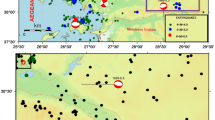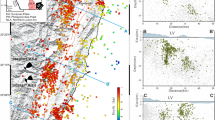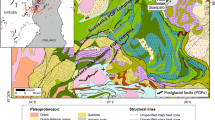Abstract
Large earthquake-triggered landslides near a seismogenic fault are usually closely linked to fault slipping. Therefore, it is important to research the relationship between the landslide movement and the deformation pattern of faults to better understand the location and influencing factors related to the large landslides. A large landslide, on the right bank of the Clarence River, New Zealand, was reactivated during the 2016 Mw 7.8 Kaikoura earthquake. The landslide is located in close proximity to the Papatea Fault which ruptured during the earthquake. The special tectonic location of this landslide provided favorable conditions to research the failure mechanism of earthquake-triggered landslides. Field investigation and remote-sensing images revealed that the co-seismic surface rupture zone of the Papatea Fault is relatively complicated and characterized by a wide deformation zone with a width of ~80–170 m. The northern section showed as left-lateral strike-slip and thrust-slip, with a vertical displacement of up to 4–6 m. However, it exhibited thrust motion in the Clarence landslide area. The Clarence landslide was a reactivation of a pre-existing landslide. The thrust faulting of the Papatea Fault produced a wide deformation and fractured zone near the top of the landslide mass, and resulted in over-steepened topography in the landslide area. It should be noted that long-team seismic shaking, especially the main frequency of the seismic acceleration and rapid co-seismic vertical slip of the fault, played the principal role in further accelerating topographic instability during the earthquake. The landslide body thus started to slide along a pre-existing sliding surface under these actions. Our results indicate that the deformation pattern of the seismogenic fault could also play an important role in the occurrence of earthquake-triggered landslides, in addition to geological and geomorphological conditions and local seismic acceleration.















Similar content being viewed by others
References
Bradley BA, Razafindrakoto HNT, Polak V (2017) Ground-motion observations from the 14 November 2016 mw 7.8 Kaikoura, New Zealand, earthquake and insights from broadband simulations. Seismol Res Lett 88:740–756. https://doi.org/10.1785/0220160225
Chang TY, Cotton F, Tsai YB, Angelier J (2004) Quantification of hanging-wall effects on ground motion: some insights from the 1999 Chi-Chi earthquake. Bull Seismol Soc Am 94:2186–2197
Chang KJ, Taboada A, Chan YC (2005) Geological and morphological study of the Jiufengershan landslide triggered by the Chi-Chi Taiwan earthquake. Geomorphology 71:293–309. https://doi.org/10.1016/j.geomorph.2005.02.004
Chen XL, Yu L, Wang MM, Lin CX, Liu CG, Li JY (2014) Brief communication: landslides triggered by the Ms = 7.0 Lushan earthquake, China. Nat Hazards Earth Syst Sci 14:1257–1267. https://doi.org/10.5194/nhess-14-1257-2014
Chigira M, Wang WN, Furuya T, Kamai T (2003) Geological causes and geomorphological precursors of the Tsaoling landslide triggered by the 1999 Chi-Chi earthquake, Taiwan. Eng Geol 68:259–273
Cowan HA (1991) The North Canterbury earthquake of September 1, 1888. J R Soc New Zeal 21:1–12. https://doi.org/10.1080/03036758.1991.10416105
Fu R (2011) Study on dynamic response of Donghekou slope in Qingchuan County under the Wenchuan earthquake (in Chinese). Master thesis, Chengdu University of Technology
Gorum T, Fan XM, Westen CJV, Huang RQ, Xu Q, Tang C, Wang GH (2011) Distribution pattern of earthquake-induced landslides triggered by the 12 may 2008 Wenchuan earthquake. Geomorphology 133:152–167. https://doi.org/10.1016/j.geomorph.2010.12.030
Griffiths DW, Bollinger GA (1979) The effect of Appalachian Mountain topography on seismic waves. Bull Seismol Soc Am 69:1081–1105
Hamling IJ, Hreinsdottir S, Clark K, Elliott J, Liang CR, Fielding E, Litchfield N, Villamor P, Wallace L, Wright TJ, Anastasio ED, Bannister S, Burbidge D, Denys P, Gentle P, Howarth J, Mueller C, Palmer N, Pearson C, Power W, Barnes P, Barrell DJA, Dissen RV, Langridge R, Little T, Nicol A, Pettinga J, Rowland J, Stirling M (2017) Complex multifault rupture during the 2016 Mw 7.8 Kaikoura earthquake, New Zealand. Science 356:1–10. https://doi.org/10.1126/science.aam7194
Hancox G, Perrin N, Dellow G (2002) Recent studies of historical earthquake-induced landsliding, ground damage, and MM intensity in New Zealand. Bull N Z Soc Earthq Eng 35:59–95
Huang RQ, Pei XJ, Fan XM, Zhang WF, Li SG, Li BL (2011) The characteristics and failure mechanism of the largest landslide triggered by the Wenchuan earthquake, may 12, 2008, China. Landslides 9:131–142. https://doi.org/10.1007/s10346-011-0276-6
Kaiser A, Balfour N, Fry B, Holden C, Litchfield N, Gerstenberger M, D’Anastasio E, Horspool N, McVerry G, Ristau J, Bannister S, Christophersen A, Clark K, Power W, Rhoades D, Massey C, Hamling I, Wallace L, Mountjoy J, Kaneko Y, Benites R, Houtte CV, Dellow S, Wotherspoon L, Elwood K, Gledhill K (2017) The 2016 Kaikōura, New Zealand, earthquake: preliminary seismological report. Seismol Res Lett 88:727–739. https://doi.org/10.1785/0220170018
Kargel JS, Leonard GJ, Shugar DH, Haritashya UK, Bevington A, Fielding EJ, Fujita K, Geertsema M, Miles ES, Steiner J, Anderson E, Bajracharya S, Bawden GW, Breashears DF, Byers A, Collins B, Dhital MR, Donnellan A, Evans TL, Geai ML, Glasscoe MT, Green D, Gurung DR, Heijenk R, Hilborn A, Hudnut K, Huyck C, Immerzeel WW, Liming J, Jibson R, Kaab A, Khanal NR, Kirschbaum D, Kraaijenbrink PD, Lamsal D, Liu SY, Lv MY, McKinney D, Nahirnick NK, Nan ZT, Ojha S, Olsenholler J, Painter TH, Pleasants M, Pratima KC, Yuan QI, Raup BH, Regmi D, Rounce DR, Sakai A, Donghui S, Shea JM, Shrestha AB, Shukla A, Stumm D, Van der Kooij M, Voss K, Xin W, Weihs B, Wolfe D, Wu LZ, Yao XJ, Yoder MR, Young N (2016) Geomorphic and geologic controls of geohazards induced by Nepal’s 2015 Gorkha earthquake. Science 351:aac8353. https://doi.org/10.1126/science.aac8353
Khazai B, Sitar N (2004) Evaluation of factors controlling earthquake-induced landslides caused by Chi-Chi earthquake and comparison with the Northridge and Loma Prieta events. Eng Geol 71:79–95. https://doi.org/10.1016/s0013-7952(03)00127-3
Langridge R, Campbell J, Hill N, Pere V, Pope J, Pettinga J, Estrada B, Berryman K (2003) Paleoseismology and slip rate of the Conway segment of the hope fault at Greenburn stream, South Island, New Zealand. Ann Geophys 46:1119–1139
Langridge RM, Ries WF, Litchfield NJ, Villamor P, Van Dissen RJ, Barrell DJA, Rattenbury MS, Heron DW, Haubrock S, Townsend DB, Lee JM, Berryman KR, Nicol A, Cox SC, Stirling MW (2016) The New Zealand active faults database. NZ J Geol Geophys 59:86–96
Mao YL, Hu GT, Mao XH, Shi YW (2005) Mechanism of set-out violent-slide of slope mass during earthquake and its simulation by suing discrete element method (in Chinese). J Eng Geol 9:74–80
Mason DPM, Little TA (2006) Refined slip distribution and moment magnitude of the 1848 Marlborough earthquake, Awatere fault, New Zealand. N Z J Geol Geophys 49:375–382. https://doi.org/10.1080/00288306.2006.9515174
Meunier P, Hovius N, Haines JA (2008) Topographic site effects and the location of earthquake induced landslides. Earth Planet Sci Lett 275:221–232. https://doi.org/10.1016/j.epsl.2008.07.020
Nicol R, Cox S, Langridge R, Pedley K (2010) Surface rupture of the Greendale fault during the mw 7.1 Darfield (Canterbury) earthquake, New Zealand: initial findings. Bull N Z Soc Earthq Eng 43:1–7
Shi XH, Wang Y, Liu-Zeng J, Weldon R, Wei SJ, Wang T, Sieh K (2017) How complex is the 2016 mw 7.8 Kaikoura earthquake, South Island, New Zealand? Sci Bull 62:309–311. https://doi.org/10.1016/j.scib.2017.01.033
Stewart S (2007) Rock mass strength and deformability of unweathered closely jointed New Zealand greywacke. PhD thesis, University of Canterbury Christchurch
Wu HZ (2010) Study on analysis method for spectrum of seismic landslide (in Chinese). PhD thesis, Institute of Rock and Soil Mechanics, Chinese Academy of Sciences
Wu G, Cunningham D, Yuan RM, Zhou Q, Zeng XF, Yang XP (2017) Mass-wasting effects induced by the 2015 Gorkha (Nepal) mw 7.8 earthquake within a large paleo-landslide site adjacent to the Tatopani Border Station, Nepal: implications for future development along the critical Bhote Koshi River valley transport corridor between Nepal and China. Landslides 14:1147–1160. https://doi.org/10.1007/s10346-016-0792-5
Yan ZX, Zhang XD, Zhang S, Zhang LP, Cao XH (2011) Study on resonance characteristics and natural frequency of slope under bi-directional seismic action (in Chinese). Hydrog Eng Geol 38:46–51
Yin YP, Wang FW, Sun P (2009) Landslide hazards triggered by the 2008 Wenchuan earthquake, Sichuan, China. Landslides 6:139–152. https://doi.org/10.1007/s10346-009-0148-5
Yuan RM, Xu XW, Chen GH, Tan XB, Klinger Y, Xing HL (2010) Ejection landslide at northern terminus of Beichuan rupture triggered by the 2008 mw 7.9 Wenchuan earthquake. Bull Seismol Soc Am 100:2689–2699. https://doi.org/10.1785/0120090256.
Yuan RM, Deng QH, Cunningham D, Xu C, Xu XW, Chang CP (2013) Density distribution of landslides triggered by the 2008 Wenchuan earthquake and their relationships to peak ground acceleration. Bull Seismol Soc Am 103:2344–2355. https://doi.org/10.1785/0120110233
Yuan RM, Tang CL, Deng QH (2014) Effect of the acceleration component normal to the sliding surface on earthquake-induced landslide triggering. Landslides 12:335–344. https://doi.org/10.1007/s10346-014-0486-9
Zheng WH, Lu MY (2005) A preliminary study on mechanism of dynamic triggering of earthquakes (in Chinese). Chin J Geophys 48:116–123
Acknowledgements
The authors would like to express sincere appreciation to the reviewers for their valuable comments and suggestions, which were helpful for improving the MS. This work was financially supported by the key project of the Basic Science Fund of the Institute of Geology, China Earthquake Administration (IGCEA-1604), and the National Natural Science Foundation of China (41372219). We would also like to express our deep appreciation to Nicola Litchfield, Robert M Langridge, Russ J Van Dissen and Pilar Villamor from GNS Science, Lower Hutt, New Zealand, for providing detailed geological material and extensive exchanges.
Author information
Authors and Affiliations
Corresponding author
Rights and permissions
About this article
Cite this article
Guo, P., Han, Zj., Ran, Hl. et al. Co-seismic surface rupture of Papatea fault and reactivation mechanism of the Clarence landslide during the 2016 Mw7.8 Kaikoura earthquake, New Zealand. Bull Eng Geol Environ 78, 3055–3068 (2019). https://doi.org/10.1007/s10064-018-1338-y
Received:
Accepted:
Published:
Issue Date:
DOI: https://doi.org/10.1007/s10064-018-1338-y




